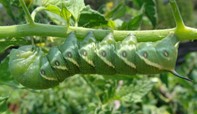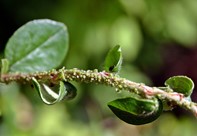By Laurie Bryant
Oracle Community Learning Garden
Each season brings its own challenges to the gardener. The life cycle of some of our more bothersome garden pests are also linked closely to the season of the year. Warm weather brings out most of the pests. We say they “overwinter” in the soils in our garden and emerge with the warmer weather..
We’ve had some much needed rain this summer. I couldn’t believe how green the desert and our yards became after the rains and how quickly it happened (dust off those lawnmowers!). But the increased heat and moisture makes a comfortable habitat for the insects, too, so we have seen an increase in the pests.
So we can look at different ways to prevent severe damage to our plants from harmful insects. There are many products available and this is a personal choice for your own garden. But here at the Oracle Community Learning Garden, we choose to avoid any pesticide or harmful chemical sprays and treatment. If you do purchase commercial pesticides, research the long lasting effects on beneficial insects and pollinators.
The biggest step we can all take in the fight against the harmful insects in our garden is BE OBSERVANT. Look at your plants every day. These bugs are small. Often the first sign we have is a yellowing or wilting of our plant, or telltales holes on the leaves. By examining the tops and bottoms of leaves, and along the stem, we can often see eggs, or frass (poop left by the insects). Some of the larvae which do most of the damage are large, like caterpillars, but some are tiny or can be buried inside the vine. So watching your plant closely is the key to controlling the damage. If you see eggs on the leaves, you can wipe them off using an insecticidal soap at this stage.
Lace bugs: These are one of the first things we noticed. We had a lot of “volunteer” sunflowers around the garden, and this is a favorite plant of lace bugs. The lace bug is a tiny, gray and white bug that feed on the underside of leaves. With piercing-sucking mouthparts characteristic of a “true bug’, they pump out plant sap. The leaves then dry up and turn yellow. We handled them with daily water spray. Ladybugs and other beneficial insects will help control them, too

Tomato Hornworm: By the time we see these guys, they can eat all the leaves from a tomato plant before you can blink an eye. This is a larval stage of a large grey or brown moth. These hornworms can be handpicked and disposed of, and here at OCLG several of our gardeners have chickens which are happy to get these tasty snacks. They are fairly well camouflaged but once you’re used to looking for them they show right up. Especially at night with a black light.
Powdery mildew: Powdery mildew is a group of diseases caused by fungi. Powdery mildews are characterized by spots or patches of white to grayish, talcum-powder-like growth. We find them on all kinds of squash We’ve seen several cases of this and have used a spray of 40/60 whole milk/water to the leaves of plants in sunlight, This has been used in many areas, as the milk proteins act as a deterrent. to this fungi.

Aphids: Gardeners are pretty familiar with groups of light green aphids along the stems and underside of leaves, as aphids manage to get into almost every garden. The easiest way is daily inspection and wiping them off, but this can be time consuming. Insecticidal soap spray can be used. This year we released ladybugs and green lacewings; These beneficial insects will devour as many aphids as they can get. There also a parasitic wasp that eats aphids. You can order these from companies specializing in organic gardening supplies and natural pest control solutions.
Verticillium Wilt: This is a fungal disease that attacks many plants. We noticed it on our tomatoes. It enters through the root system and travels through the vascular system. The leaves wilt and turn yellow to brown. There really is no cure and if one plant is affected, it’s better to destroy that plant. And please don’t put diseased plant material in your compost pile.
Vine Borer Squash Bug: Since the pumpkin patch at OCLG is a favorite, this squash bug can be devastating. And they are hard to spot since the larva burrow into the base of the vine and live in there, eating all the nutrients as it grows . Look at the base of your squash vines for sign of a small hole and sawdust like material which indicates a critter is already in your vine. Also look for flat, oval brown eggs along the stems in late spring or early summer.

This is a just a brief overview of a few cases. There’s a lot of information out there, Please share any ideas or experience you have had with combating harmful pests in your garden. Send us an email at oraclegardening@gmail.com or call Laurie at 910-670-5665.
